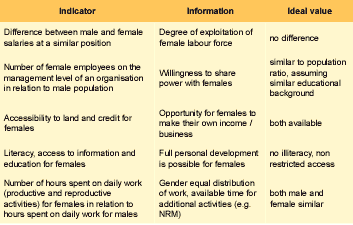Gender Mainstreaming - Principles and General Procedures
|
|
As Gender Mainstreaming is a holistic approach, it is only possible to outline briefly the main principles to be followed. These principles vary with the context. In general, the following seven steps represent the main milestones within in iterative process: 1. Analysis of a given situation Collection and analysis of available data can give a first insight on the gender balance of a situation. This main questions include: Are genderdisaggregated statistics available and what do they represent? Is additional research required to clarify the current situation? 2. Creating awareness on gender issues within a given context In most cases, gender inequalities and inequities are barley perceived as a major problem. Traditional values within a society represent the norm, and there are few opportunities of comparing this norm with alternatives. Group discussions within male and female groups lead to more details on the “blurred” image of inequalities. Therefore, presentation material from the analysis can give a clear image (let the facts speak) of an existing gender imabalance. Gender mainstreaming has to be addressed on different political levels: a) Legislative level The development of laws and regulations form the legal basis as a backbone for gender mainstreaming. Although “de jure” laws deviate from “de facto” laws (formal and real equality), it is of utmost importance to incorporate gender issues on the policy level, when the process of removing the gender imbalance shall take place. Existing laws have to be reviews according to its impact on gender mainstreaming. b) Institutional level A detailed analysis of institutional set-ups shows, how much gender balance is given to share power within an institution or organisation. In general, many committees are dominated by males, while females are highly underrepresented. Politically important positions are mostly dominated by men. A discussion can be initiated, which analyses the reasons and impacts on the status quo of the gender ratio as well as pinpointing gender inequities. c) Community level While the work of men is often linked to higher importance as it forms the income of a household economy (productive activities), the efforts being spent on basic reproductive work (fetching water, cooking, washing, looking after children) done by females is often underestimated, even by themselves. The development of a gender resource map helps the males and females to identify the workload and its impact on daily life. It might be helpful to discuss the coping mechanisms, in case of sickness of the one or the other family member. This also shows, that both male and female work is indispensable for a household. 3. Identification of feasible measures which consider and alleviate gender inequalities After all groups concerned have been sensitised about the impact of gender inequalities in a first step, tangible measures and activities have to be defined and prioritised, in order to improve the overall situation and to (partly) alleviate the gender imbalance. This has to be done on various levels with different priorities, while the scope of activities is limited by the available budget. Measures can be differentiated according to: The policy level:
Institutional / organisational level:
Community level:
After collecting all ideas in a moderated process, the feasibility and priority of all possible measures have to be identified. Most important is to get commitments from all actors involved and to define clear responsibilities in order to carry out these measures successfully. In some cases, a Project Planning Matrix can support the implementation. Certainly, necessary resources (workload, money) have to be available to ensure the feasibility of an activity. 4. Identification of Indicators (benchmarks) and preconditions which reflect the success of Gender Mainstreaming efforts While indicators reflect the degree to which an activity leads to the desired objective, preconditions have to be defined, under which the activities can be performed. In case the conditions change, the implementation of activities has to be redesigned or stopped. A multitude of context specific indicators can be identified. Table 1 shows a number of possible indicators, additions can be made if deemed necessary. |
|
|
Table 1: Indicators on gender mainstreaming
5. Discussion on all impacts of these measures with sensitised experts A detailed discussion on the level of intervention and the impact on gender mainstreaming has to be undertaken by a group of relevant experts drawn from all stakeholders. A high level of committment from all involved organisations ensures a successful implementation of gender mainstreaming in all planned activities. 6. Implementation of the above stated measures After defining and prioritising feasible measures on Gender Mainstreaming, all activities have to be implemented by the stakeholders identified. 7. Monitoring the impact of these measures, adaptation on demand While Gender mainstreaming is an iterative process to reduce and eliminate gender inequalities and gender inequities, the impact of all measures has the be monitored. Measures have to be refined or stopped, if they do contribute towards the objective, or if severe side effects can be observed. Indicators, determining the impact on the activities, can be used to objectively judge about the progressing achievement. |

